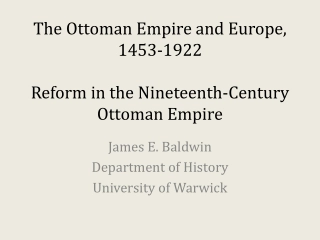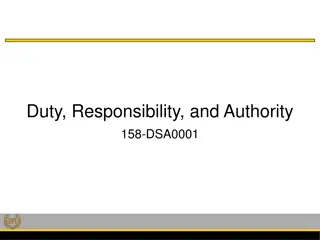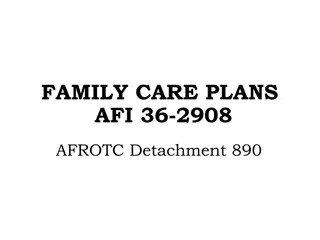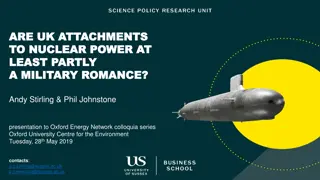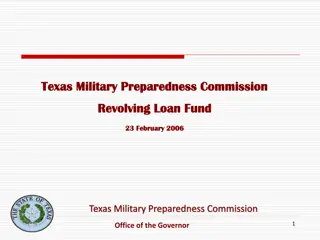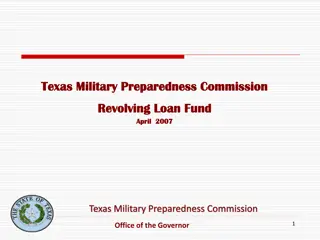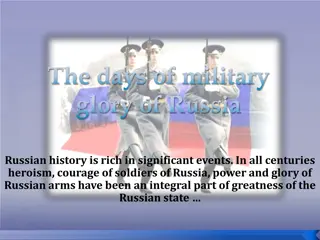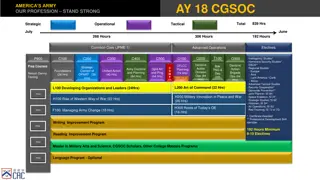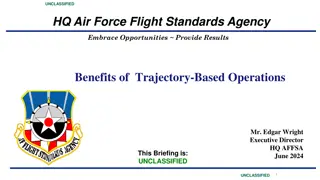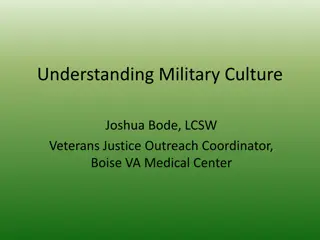
Understanding Military Explosives: Types and Characteristics
Explore the world of military explosives, including the different categories, key characteristics, and commonly used energetic compounds like TNT, RDX, and HMX. Learn about the stringent requirements for military explosives and the factors that make them acceptable for standardization.
Download Presentation

Please find below an Image/Link to download the presentation.
The content on the website is provided AS IS for your information and personal use only. It may not be sold, licensed, or shared on other websites without obtaining consent from the author. If you encounter any issues during the download, it is possible that the publisher has removed the file from their server.
You are allowed to download the files provided on this website for personal or commercial use, subject to the condition that they are used lawfully. All files are the property of their respective owners.
The content on the website is provided AS IS for your information and personal use only. It may not be sold, licensed, or shared on other websites without obtaining consent from the author.
E N D
Presentation Transcript
EXPLOSIVE A chemical explosive is a compound or mixture which, upon the application of heat or shock, decomposes or rearranges with extreme rapidity, yielding much gas and heat. For a chemical to be an explosive, it must exhibit all of the following: Formation of gases : a burning combustible forms gases Evolution of heat : Rapid generation and liberation of heat in large quantities accompanies every explosive chemical reaction that causes the gaseous products of reaction to expand and generate high pressures. Rapidity of reaction : Unless the reaction occurs rapidly, the thermally expanded gases will be dissipated in the med- ium, and there will be no explosion. Initiation of reaction : must be capable of being initiated by the application of shock or heat to a small portion of the mass of the explosive material. A material in which the first three factors exist cannot be accepted as an explosive unless the reaction can be made to occur when desired.
Sensitivity : ease with which the explosive can be detonated by a shock or blow. Deflagration : Explosion maybe propagated relatively slowly by the conduction or radiation of heat from burnt part to the unburnt part. E.g. propellants Detonation : Reaction is propagated by a pressure wave action. Pressure wave : a wave that travels at high speed through the explosive substance, compressing and heating each layer of the substance . homemade explosives (HMEs) as explosives produced from precursor chemicals either physically blended or combined in a chemical reaction. precursor chemicalsas chemicals that can be used, through blending or chemical reaction, to produce HMEs. improvised explosive device (IED) as A device placed or fabricated in an improvised manner incorporating destructive, lethal, noxious, pyrotechnic or incendiary chemicals and designed to destroy, incapacitate, harass or distract. It may incorporate military stores, but is normally devised from non-military components.
CATEGORIES OF EXPLOSIVES Low Explosives : Smokeless powders, pyrotechniques Primary : Extremely sensitive to shock, friction and heat On the basis of rate of decomposition High Explosive Secondary : Relatively insensitive to shock, friction and heat
MILITARY EXPLOSIVES Military explosives are manufactured for specific purposes. Commonly used military energetic compounds include the explosives 2,4,6-trinitrotoluene (TNT), hexahydro-1,3,5-trinitro-1,3,5-triazine (RDX), octahydro-1,3,5,7-tetranitro-1,3,5,7-tetrazocine (HMX)
The requirements of a military explosive are stringent, and very few explosives display all of the characteristics necessary to make them acceptable for military standardization. Some of the more important characteristics are : Availability and Cost. Sensitivity Stability Power Brisance Density Volatility Hygroscopicity Toxicity
TNT TNT (2,4,5-trinitrotoluene) - C6H2(NO2)3CH3 Was dominant military explosive during World War I Was conserved during World War II by mixing it with ammonium nitrate. Characteristics of TNT: Has a low melting point not sensitive to shock Will not spontaneously explode Can include a detonator if the goal is to produce a pressure wave Can quickly change from a solid to hot, expanding gas
RDX RDX (cyclotrimethylenenitramine) /Research Department Explosive/ Royal Demolition Explosive. Also called cyclonite, hexogen and T4. Remains stable in storage and at room temperature Most powerful and brisant of the military high explosives Reaches maximum pressure so rapidly that a shock wave forms Must be used in conjunction with a detonator to produce an explosion.
C-4 Composition C-4 is a common variety of the plastic explosive. A popular explosive choice among terrorists Uses RDX as explosive agent. Military plastic explosive that is about 90% RDX; remainder is a plastic binder material and oil (Bound by a mixture of 5.3% dioctyl sebacate (DOS) or dioctyl adipate (DOA) as the plasticizer (to increase the plasticity of the explosive), thickened with 2.1% polyisobutylene (PIB, a synthetic rubber) as the binder, and 1.6% of a mineral oil often called process oil.)
HMX High-melting-point explosive. Also known as octogen. About 30% more powerful than TNT. Powerful, yet shock-sensitive, nitroamine-based high explosive Chemically related to RDX
REFERENCES https://slideplayer.com/slide/10948770/ Wikipedia

